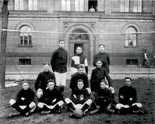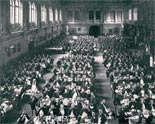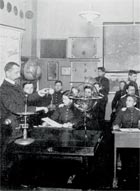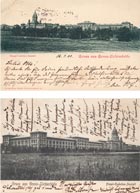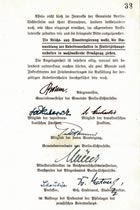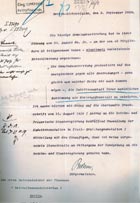
At the beginning of August 1878, the first cadets between the ages of 14 and 17 moved into the Preussische Haupkadettenanstalt (Prussian Cadets' Institute). Over the course of the next decade, the number of cadets increased steadily. In 1887 there were already 960, and starting in 1891, there were ten companies of 1,000 cadets located on the grounds.
The day was strictly regimented: 5:30 a.m. reveille, breakfast, physical training and Morning Prayer. Classes in military science, mathematics, geography, history, German, French, Latin, physics and art, followed this. In the afternoons military and sports training sessions were held. At 10 p.m. it was time for bed.
The educational program of the Kadettenanstalt was equivalent to a Realgymnasium (high school), which, after the highest grade, the final examination for a diploma could be taken. Most of the cadets in the higher classes also took the Officers' examination at the same time while others completed their schooling after middle school with a basic military exam. The Kadettensnstalt maintained this system until it disbanded on 9 March 1920.
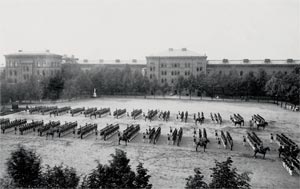
A view of one of the two large courtyards that were used for parading: the cadets training for a parade on 31 May 1906.

After the First World War, when all military facilities had to be closed according to the Treaty of Versailles, different uses for the former Hauptkadettenanstalt were discussed. While the Reichkolonialamt (Reich Colony Authorities) voiced its desire to move the Reich Archives (founded in 1919) onto the grounds, the Mayor and community of Berlin-Lichterfelde pleaded for its conversion into a civilian reform school. Twenty days after the closing of the Haupkadettenanstalt it was converted into a State Educational Institute (Stabila) by governmental decree. The curriculum for the Realgymnasium remained so that the former cadets could continue their education and eventually receive a diploma.
The transition to civilian use did not occur without problems. When the first School Director, School Inspector Dr. Fritz Karsen, a well-known school reformer, began to introduce a democratic oriented educational system in Lichterfelde, he was met with resistance from the mostly military-conservative oriented student body. Just after the opening ceremony on 5 May 1920 former cadets attempted to remove the newly raised black, red and gold flag from its mast.
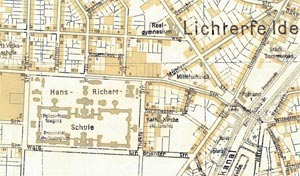
A section of a Berlin map from 1932. The Stabila was renamed in honor of the School Director to the "Hans-Richert-Schule". Today's Finckensteinallee was previously called Zehlendorfer Straße.
They also continued to practice marching and lining up for roll call on their own and rebelled against the disbanding of the companies and changes in quarters by order of the school administration. Karsen had to resign after only three months. The new, temporary director, Privy Councillor for Studies Hartung, chose to allow the previous, self-governing student body. Although a middle school was also attached to the high school, the number of new students decreased. The school year 1920/21 opened with only 300 boarding school students and 39 guest students.
In 1922, Hans Richert assumed leadership of the school. He continued with Karson's reforms and ordered the closure of the dining hall, with meals now having to be eaten in the smaller dining areas. In 1929 the Stabila was renamed in honor of the School Director to the "Hans-Richert-Schule, Staatliche Bildungsanstalt Berlin-Lichterfelde".
Due to the drastic decrease in student body, both east wings of the barracks stood empty. Since the 1920's these wings had housed the Provinzialschulkollegium (Provincial School Faculty) and a group from the Berliner Breitschaftspolizei (Riot Police).They moved from the grounds in 1933.
